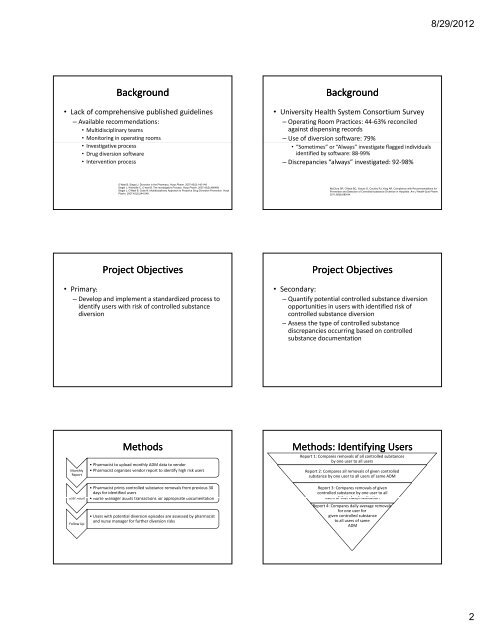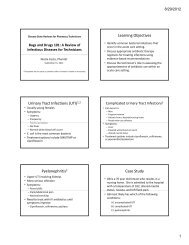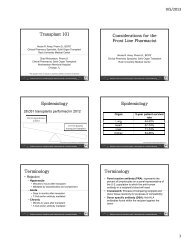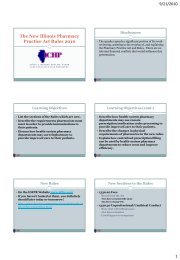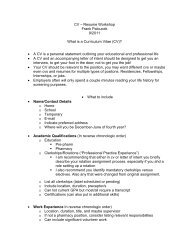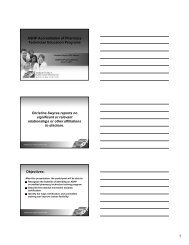Presentation Outline ICHP Annual Meeting September 13-15
Presentation Outline ICHP Annual Meeting September 13-15
Presentation Outline ICHP Annual Meeting September 13-15
Create successful ePaper yourself
Turn your PDF publications into a flip-book with our unique Google optimized e-Paper software.
Background<br />
• Lack of comprehensive published guidelines<br />
– Available recommendations:<br />
• Multidisciplinary teams<br />
• Monitoring in operating rooms<br />
• Investigative process<br />
• Drug diversion software<br />
• Intervention process<br />
O’Neal B, Siegel J. Diversion in the Pharmacy. Hosp Pharm. 2007;42(2):145-148<br />
Siegel J, Wierwille C, O’neal B. The Investigative Process. Hosp Pharm. 2007:42(2);466469<br />
Siegel J, O’Neal B. Code N: Multidisciplinary Approach to Proactive Drug Diversion Prevention. Hosp<br />
Pharm. 2007:42(2);244-248<br />
Project Objectives<br />
• Primary:<br />
– Develop and implement a standardized process to<br />
identify users with risk of controlled substance<br />
diversion<br />
Monthly<br />
Report<br />
Methods<br />
•Pharmacist to upload monthly ADM data to vendor<br />
•Pharmacist organizes vendor report to identify high risk users<br />
•Pharmacist prints controlled substance removals from previous 30<br />
days for identified users<br />
UUser AAudit di • NNurse Manager M audits di transactions i for f appropriate i ddocumentation i<br />
Follow Up<br />
•Users with potential diversion episodes are assessed by pharmacist<br />
and nurse manager for further diversion risks<br />
Background<br />
• University Health System Consortium Survey<br />
– Operating Room Practices: 44‐63% reconciled<br />
against dispensing records<br />
– Use of diversion software: 79%<br />
• “Sometimes” or “Always” investigate flagged individuals<br />
identified by software: 88‐99%<br />
– Discrepancies “always” investigated: 92‐98%<br />
McClure SR, O’Neal BC, Grauer D, Couldry RJ, King AR. Compliance with Recommendations for<br />
Prevention and Detection of Controlled-substance Diversion in Hospitals. Am J Health-Syst Pharm.<br />
2011;68(8):689-94.<br />
Project Objectives<br />
• Secondary:<br />
– Quantify potential controlled substance diversion<br />
opportunities in users with identified risk of<br />
controlled substance diversion<br />
– Assess the type of controlled substance<br />
discrepancies occurring based on controlled<br />
substance documentation<br />
Methods: Identifying Users<br />
Report 1: Compares removals of all controlled substances<br />
by one user to all users<br />
Report 2: Compares all removals of given controlled<br />
substance by one user to all users of same ADM<br />
Report 3: Compares removals of given<br />
controlled substance by one user to all<br />
users of that class/medication<br />
Report 4: Compares daily average removals<br />
for one user for<br />
given controlled substance<br />
to all users of same<br />
ADM<br />
8/29/2012<br />
2


